Apple variety Bayan
Gardening in Siberia is a risky business. Rare seedlings could survive the harsh winter, so in the spring they had to plant again. In the harsh climate, dwarf crops with small fruits were mainly grown. Long-term work of breeders led to a real breakthrough, apple varieties were created that showed resistance to prolonged frost periods. In 1984, in Gorno-Altaysk, scientists bred a new apple tree named Bayana. Altai purple (as a winter-hardy parental initial form) and a selected hybrid (Gornoaltaiskoe and Bellefleur-Kitayka) under number 11 - 61 295. The resulting novelty successfully combined good winter hardiness and large-fruited. In 2003, our heroine was accepted for variety trials, and in 2007 she was included in the State Register of Breeding Achievements of Russia. The region of admission to cultivation is West Siberian (Altai Republic, Altai Territory, Kemerovo, Novosibirsk, Omsk, Tomsk and Tyumen regions). Applicant and originator - Federal State Budgetary Scientific Institution "Federal Altai Scientific Center of Agrobiotechnology". Currently, our heroine is one of the most common varieties in Siberia. The variety is considered very promising, as it has a high economic efficiency for the production of fruits.
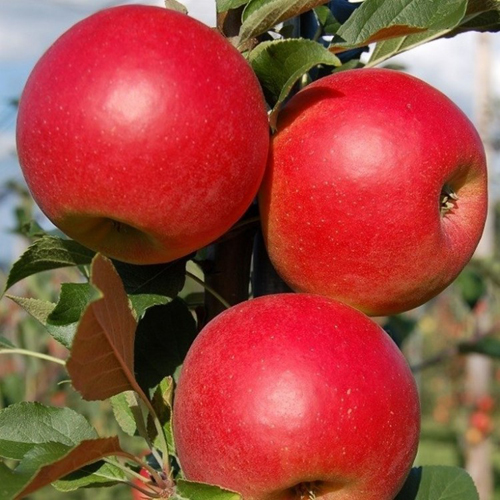
Description
The culture is medium-sized, active growth rates are observed in young plants. By the age of 10, the height of the tree reaches about 3 meters, the maximum height is 4.0 - 4.5 meters. The diameter of the medium thickened crown is about 3.5 meters. According to the State Register, the shape of the apple tree crown is narrow-pyramidal, other sources describe the shape as broom-shaped. The annual growth of horizontal branches per year is 6.0 - 7.0 cm, vertical - 9.0 - 11.0 cm. The arrangement of the shoots is compact, they depart from the trunk at an angle of about 60 °, the ends of the shoots are directed upwards. The cross section of the shoots is round. The bark is reddish-brown, pubescent, the lentils are light, oval, slightly convex. Leaves are green, medium-sized, elongated-oval, short-pointed apex, rounded-wedge-shaped base, serrate-crenate edge, broad-wavy. The surface of the leaf blade is slightly wrinkled, slightly shiny. The petiole is of medium length and width, slightly pubescent, uncolored. The type of fruiting Bayan is mixed.
The fruit of the apple tree has a bright, attractive appearance. The shape of the apples is round, slightly ribbed. The skin is smooth, dry to the touch, dull, strong, some even call it somewhat rough. The main color is greenish-yellow, the integumentary color is in the form of a blurred, subtle striped purple blush on most of the fruit. The subcutaneous points are practically invisible, they are small, greenish, in a small amount. During the ripeness period, the surface of the apple is covered with a gray waxy coating. The pulp has a pleasant creamy color, very juicy, delicate, fine-grained consistency, moderate aroma. The taste is wonderful, sweet and sour. Assessment of tasters 4.6 points. 100 grams of raw pulp contains 18% of dry matter, 14% of sugars, 0.53% of acids, 21 mg of vitamin C. Large-fruited, which is rarely inherent in varieties cultivated in Siberia, also attracts in culture. The mass of the apple according to the State Register is 165 grams. Although, according to other sources, the minimum weight of the fruit is 90 grams, the maximum is 140 grams.
Characteristics
- The button accordion can be called fast-growing. Even in unfavorable conditions, the crop can be formed in the 3rd or 4th year after planting;
- usually the apple tree blooms from May 3 to 20, but in the conditions of the foothill Altai, flowering begins a little earlier - on April 24. The process takes about 11 days. Its duration is significantly influenced by the weather. High air temperature reduces flowering to 5 - 6 days, low temperature, on the contrary, extends up to 18 days;
- our heroine belongs to the late autumn varieties, according to other sources of the winter ripening period.The harvest ripens in the first decade of September. The period of consumer ripeness can be determined by the purple hue that appears on the surface of the apple;
- productivity is high, increasing every year. In the first years, the crop is of medium yielding, yields about 4.1 t / ha. During the period of maximum fruiting, the yield rises to 11-14 t / ha. According to the results of 12-year observation in the Altai low mountains, the average yield with a planting pattern of 6 × 4 m was 12.3 t / ha;
- periodicity in fruiting is not noted, except that after an abnormally cold winter or after freezing, the harvest may be more scarce or absent altogether;
- the main requirement for Siberian apple trees is the ability to form sufficient winter hardiness in a short time. The resistance of our heroine to frost is formed closer to the middle of the winter period, during this period the culture is able to withstand up to -46 ° C. In the harsh winter of 2000-2001, freezing was only 1.5 points. In general, Bayana is considered winter-hardy, at the level of the standard for viability in Siberia, the Gornoaltaysky variety, which is one of the parents of our heroine;
- the variety cannot boast of high drought resistance. After variety trials, the State Register determined the insufficient (average) ability to adapt to the dry season;
- culture immunity is strong. The studies carried out have confirmed the high field resistance to scab in the conditions of the Altai low mountains. In the epiphytic years, the damage to the plant by the fungus was only 1.0 point. Thanks to this, our heroine was recognized as a promising variety for participation in breeding as a carrier of scab resistance. The ability to resist powdery mildew is also mentioned. True, some sources indicate the possibility of damage to the apple tree by cytosporosis;
- transportability at a high level, strong skin protects the crop from mechanical damage;
- keeping quality is good. The harvested fruits are perfectly stored for about 4 months;
- the way of use is universal. A high-quality crop is, of course, primarily used in its natural form. But it is also suitable for processing. Apples produce good quality jam, jam, juice, compote, you can also make cider, fruit wine.
Pollinators
Self-fertility is not mentioned in the State Register. Various internet sources provide conflicting information. Some people mention the self-fertility of our heroine. Others call it partially self-fertile and recommend planting pollinators nearby: varieties Cherry, Bolotovskoe, Arkad pink.
Planting and leaving
In cool climates, Bayan is planted in spring. The site must be open, well lit. Landing is carried out in the usual way. Young seedlings are watered more often, an adult tree is moistened less often, adjusting the frequency of watering according to the amount of natural precipitation. The main thing is that the soil in the near-trunk circle does not dry out; for the normal development of the apple tree, the soil must be in a moderately moist state. Only young trees need shelter from the winter wind. With regard to the formation of the crown, the opinions of gardeners may be opposite depending on the region. So, gardeners from the Novosibirsk region still complain about the insufficient winter hardiness of the plant. In order not to lose the tree, they recommend shaping it in a stlate-bush-like shape. With abundant snow cover, the bole and the base of the skeletal branches are under the snow. Thus, even in very harsh winters, when the shoots may freeze, the tree is able to recover very quickly. In some gardens, our heroine grows on a low trunk, so that the crown does not suffer much from the wind.
Bayana is a promising variety for such unfavorable regions as the Urals and Siberia. He proves that it is quite possible to grow an apple tree in difficult conditions.The plant is unpretentious, with good indicators of winter hardiness (on a level with Gornoaltaiskiy), high resistance to scab, characterized by high-quality large fruits and productivity. Such a set of positive qualities did not go unnoticed by breeders who are happy to attract culture to the breeding process as a donor of scab resistance, early maturity and yield. A small disadvantage is the average drought tolerance.
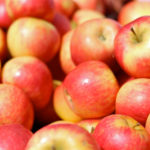
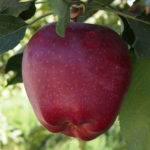
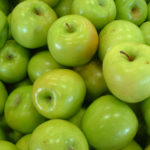
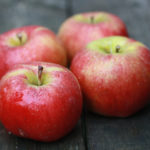
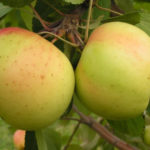
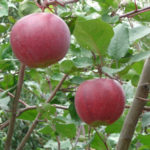



In the description I did not find all the parameters of the fruits: funnels, saucers, calyx, paw tube, axial cavity, seed nest. And so I wanted to determine the variety of my apple tree